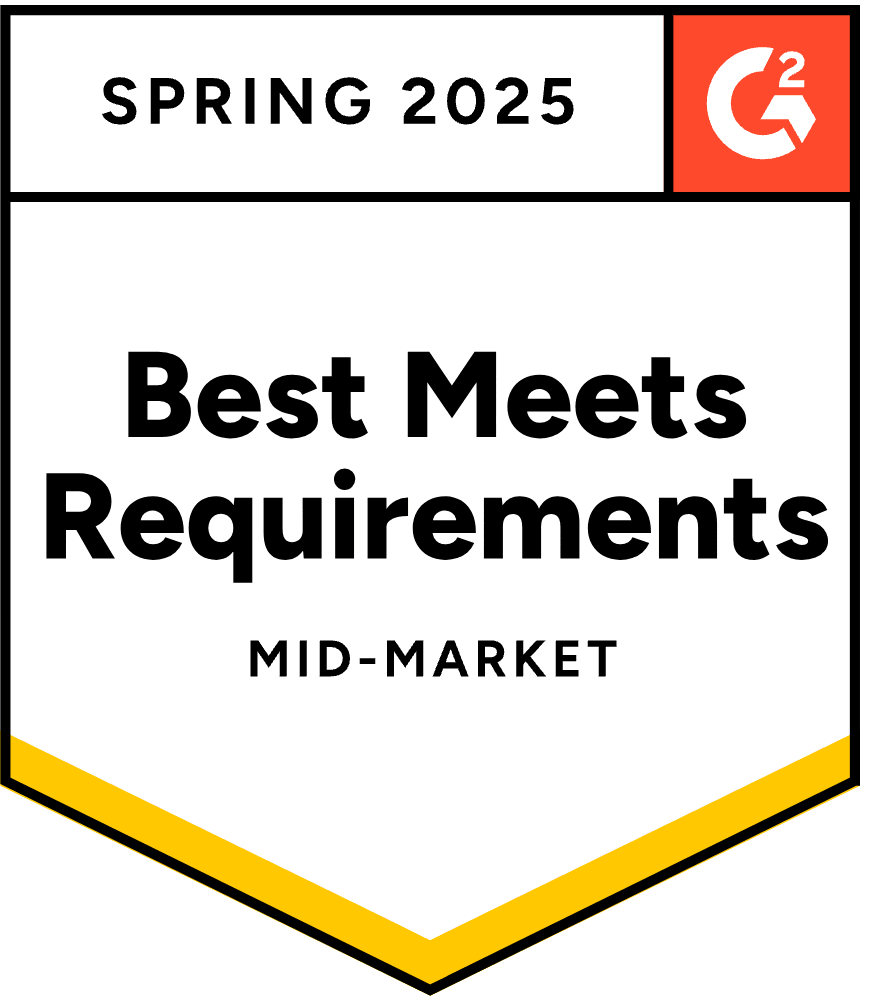- Blog
- 10 High-Converting B2B Popups That Drive Qualified Leads
10 High-Converting B2B Popups That Drive Qualified Leads
-
Barbara Bartucz
- Conversion
- 6 min read
Table of Contents
Do you run a B2B business and find yourself scratching your head about how to make popups work for you?
Popups can feel tricky in the B2B space—after all, you’re targeting decision-makers, not casual shoppers.
But here’s the good news: when done right, popups can become one of your most powerful tools for driving high-quality leads.
In this article, we’ll explore 10 examples of B2B popups that are not only attention-grabbing but also designed to convert.
Ready to take notes? Let’s dive in!
What are B2B popups?
B2B popups are not your typical “20% off” discount code deals you see on B2C websites. These overlays cater specifically to businesses, offering valuable resources like case studies, demos, free trials, or industry insights.
They’re designed to educate and guide potential business clients toward taking the next step in the buying process, with lead generation being one of the primary goals.
An exit-intent popup can be particularly effective in capturing the attention of decision-makers right before they leave the site, ensuring that the opportunity to engage with them isn’t lost.
Why do they work?
Because B2B buyers are looking for solutions that solve complex problems, not just discounts. By offering tailored, high-value content, popups can capture attention and build trust at the right moment.
How do B2B businesses use exit-intent popups?
Popups for B2B aren’t just for growing email lists. They’re part of a bigger strategy to connect with potential leads in meaningful ways.
Here’s how:
- Gathering qualified leads: It’s not about quantity but quality. These popups target decision-makers and key players in your target businesses.
- Offering high-value content: Case studies, whitepapers, and free trials directly address pain points and help buyers make informed decisions.
- Encouraging demos or consultations: A well-placed popup can gently nudge prospects into booking a demo or consultation.
However, it is crucial to avoid using multiple popups on a single page, as this can lead to user annoyance and diminished conversion rates. Moderation is key to maintaining a positive user experience.
10 B2B popup examples
Let’s see just a few examples of effective B2B popup strategies that can significantly enhance lead generation and customer engagement.
1. Surfer
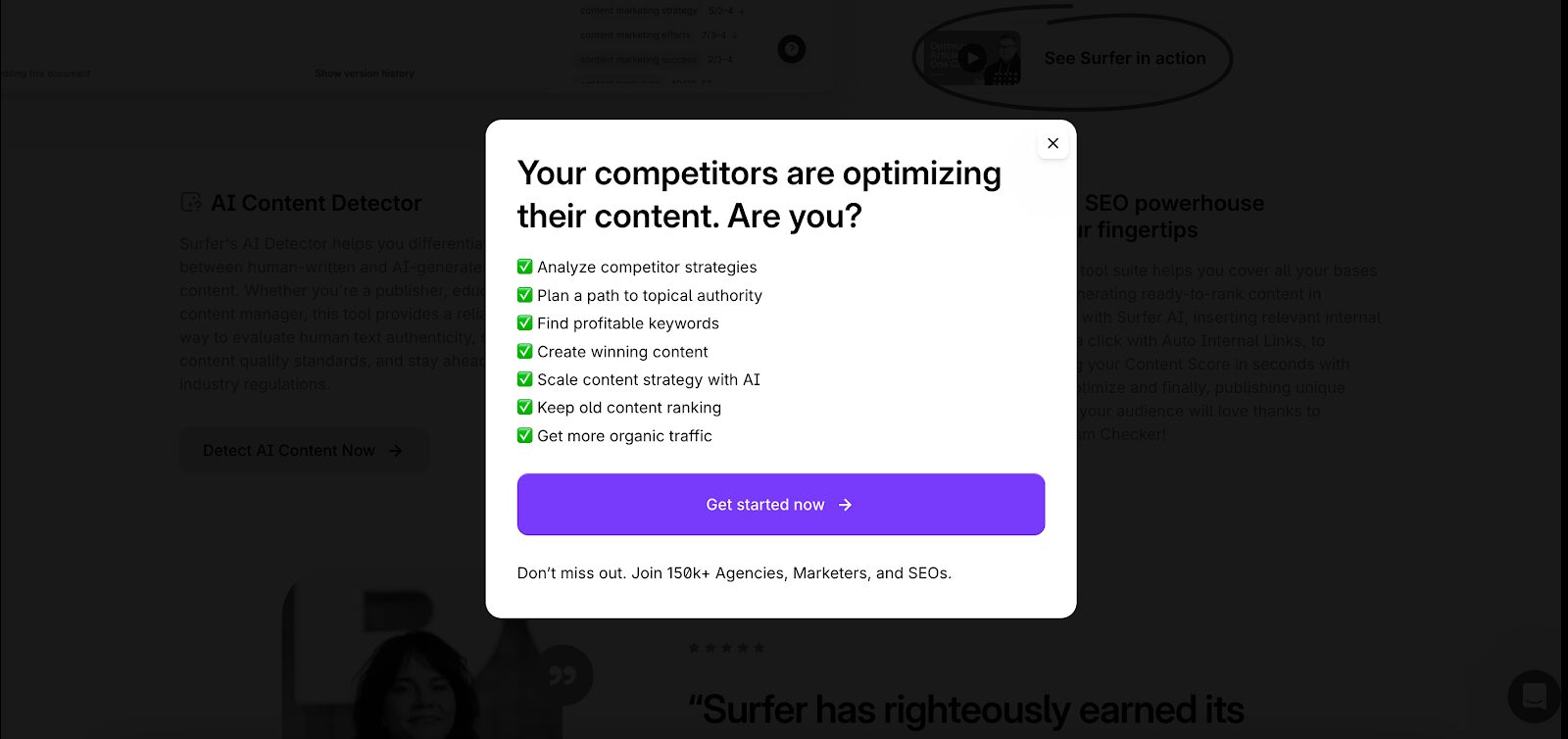
Surfer’s exit-intent popup hits the mark by making a bold comparison: “Your competitors are optimizing their content. Are you?”
If not, here’s how you can.
This direct approach taps into FOMO (fear of missing out) while offering a solution to stand out. The popup is clear, concise, and value-driven—perfect for busy professionals.
2. Synthesia
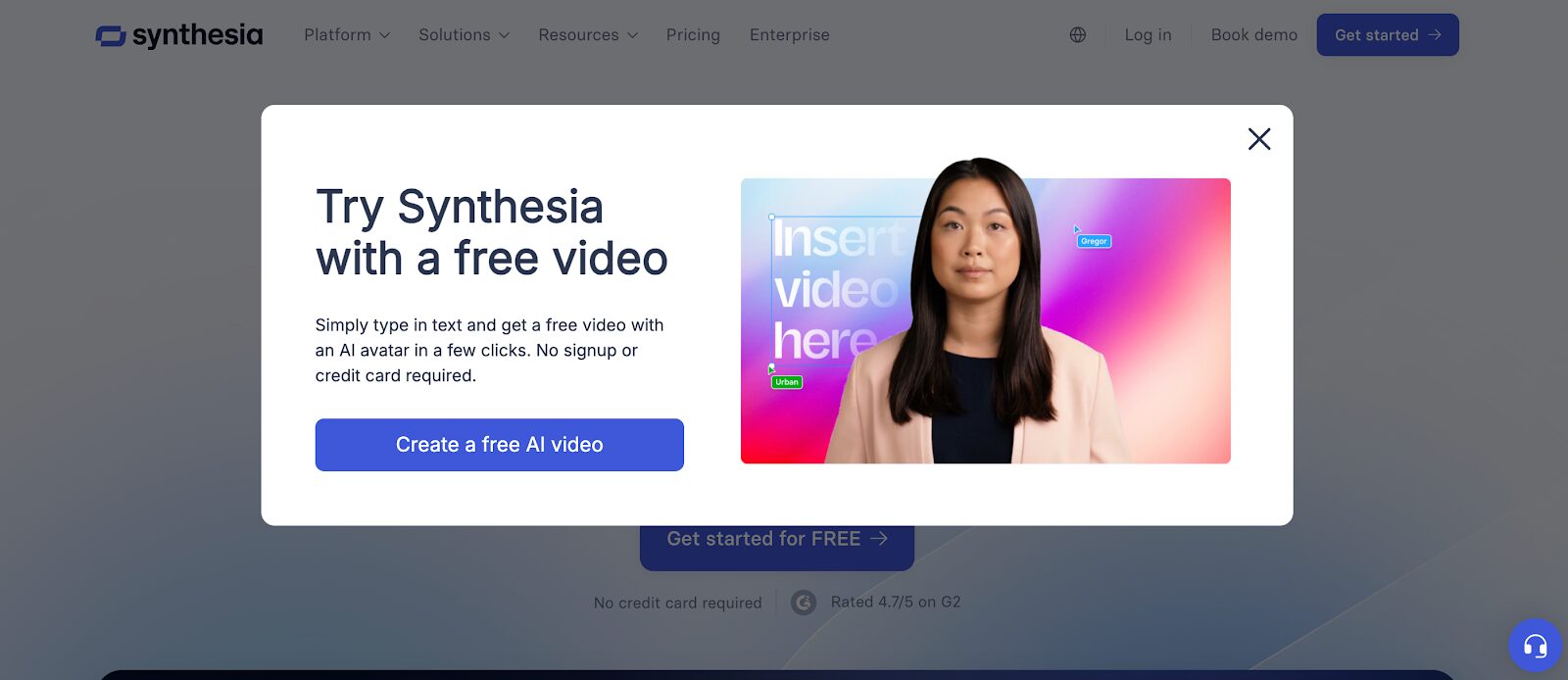
Synthesia’s exit-intent popup gets straight to the point with a compelling offer: “Create a Free AI Video.”
Their popup highlights how easy it is to get started, complete with a clear CTA button. It’s proof that simplicity combined with value can drive action.
3. Hootsuite
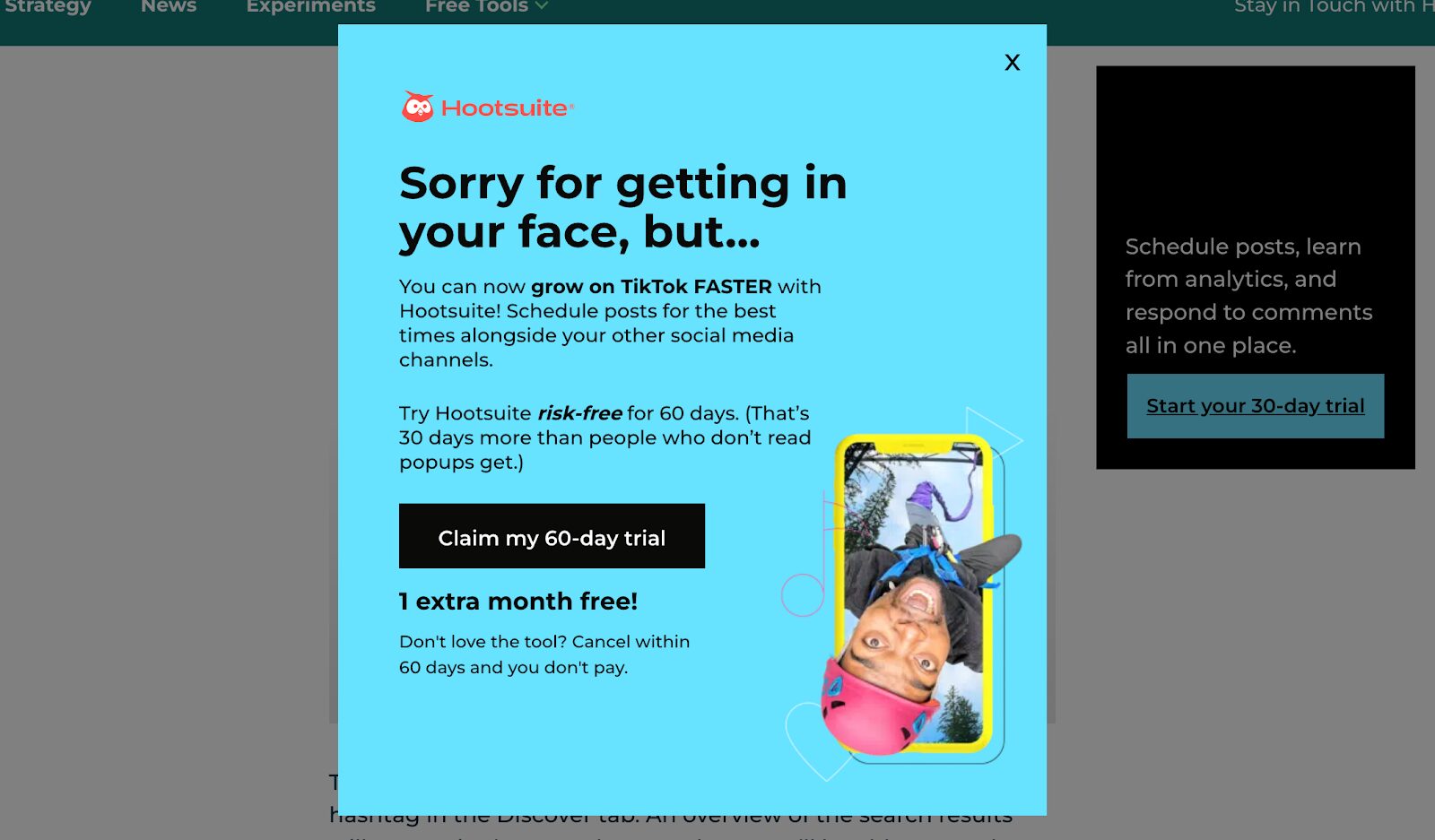
Hootsuite’s exit-intent popup is both witty and effective. Starting with “Sorry for getting in your face, but…” they inject humor to disarm users.
The popup then offers a risk-free 60-day trial, making it almost impossible to say no for one extra free month.
This strategy helps convert more visitors into leads by engaging them right before they leave the site.
4. Canva
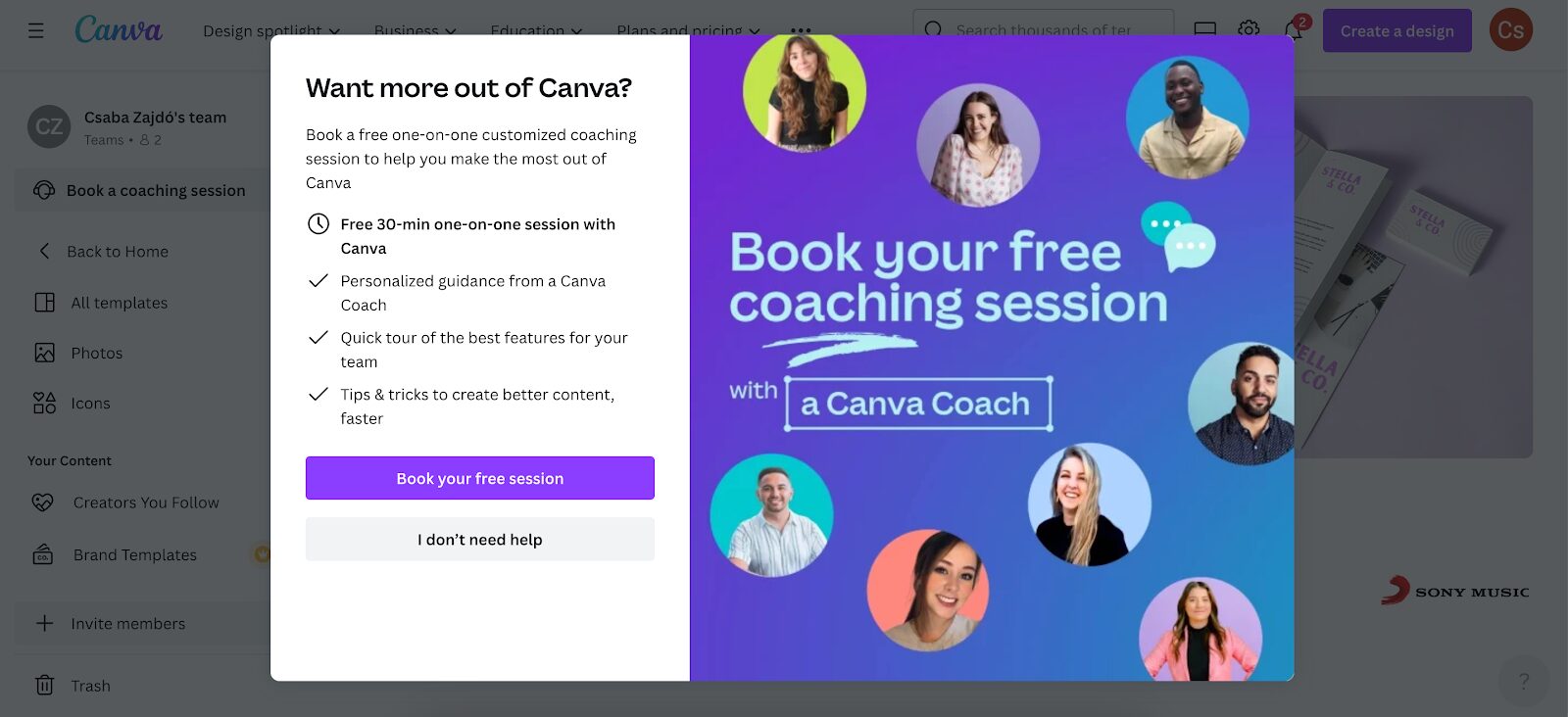
Canva takes a unique approach by offering a free 30-minute one-on-one coaching session. This goes beyond promoting their tool—it’s about helping users maximize its potential. By focusing on user success, Canva creates trust and encourages long-term engagement.
Additionally, this strategy helps provide qualified leads to the sales team, supporting their efforts by guiding potential customers closer to making a purchase.
5. Ramp
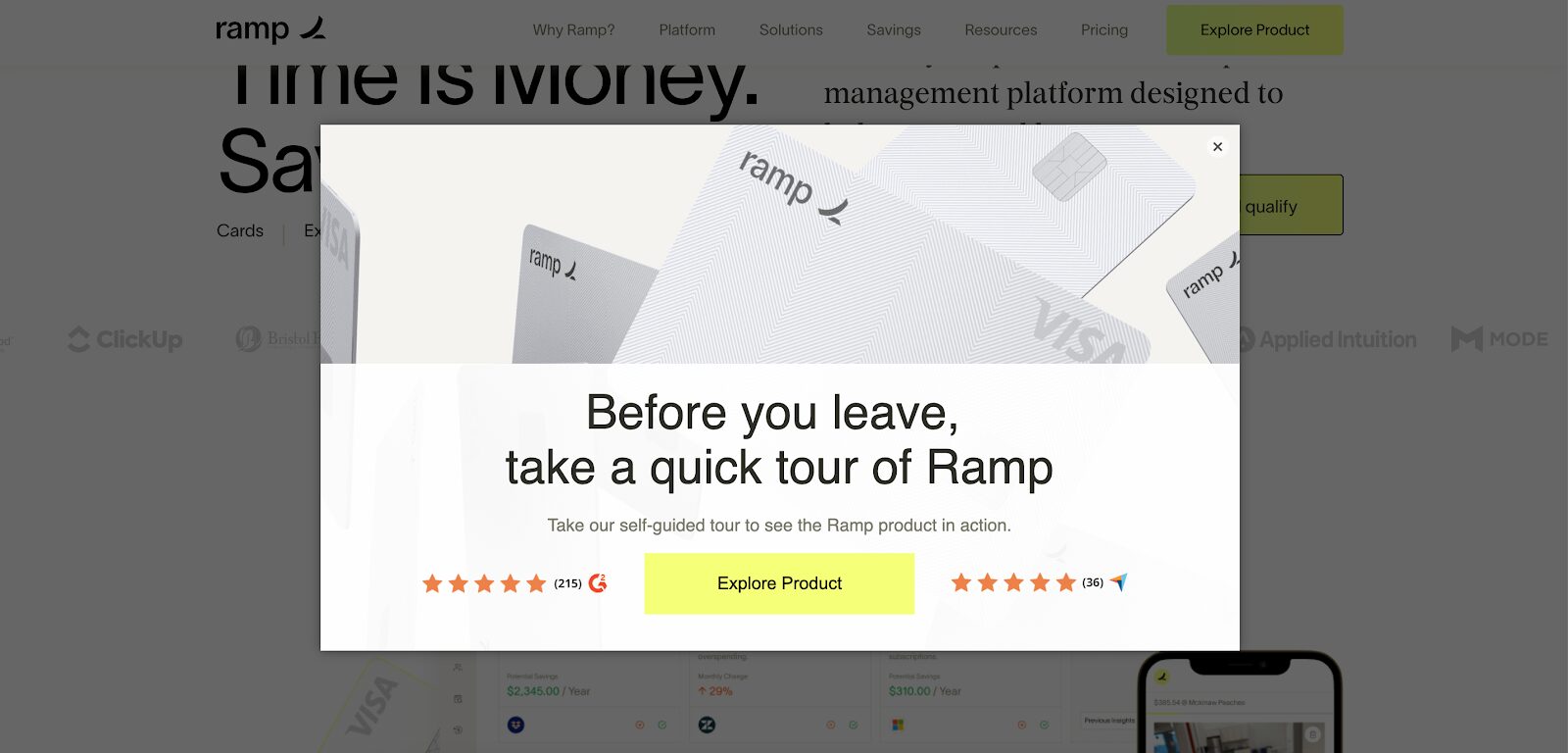
Here’s another great exit-intent popup example from Ramp’s.
Their popup leverages social proof with 5-star reviews and a quick product tour. This combination of credibility and a hands-on demo makes their offer hard to resist.
The popup doesn’t just promote; it entices users to explore the product further.
6. CoSchedule
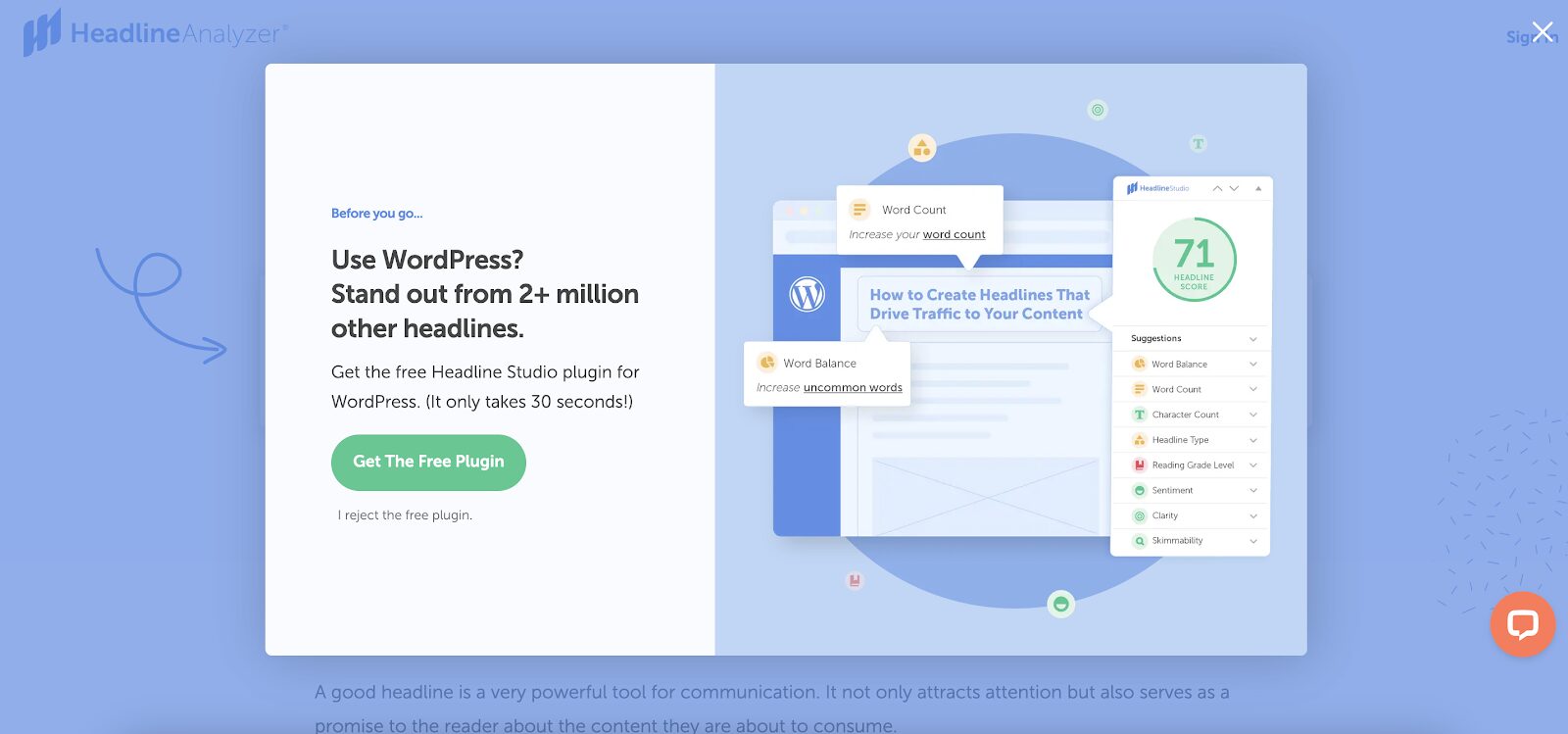
CoSchedule uses an exit-intent popup to provide immediate value.
They offer a free WordPress plugin to help users create better headlines—a small but impactful way to improve content marketing. This “try-before-you-buy” strategy is a smart move to build goodwill.
7. ClickUp
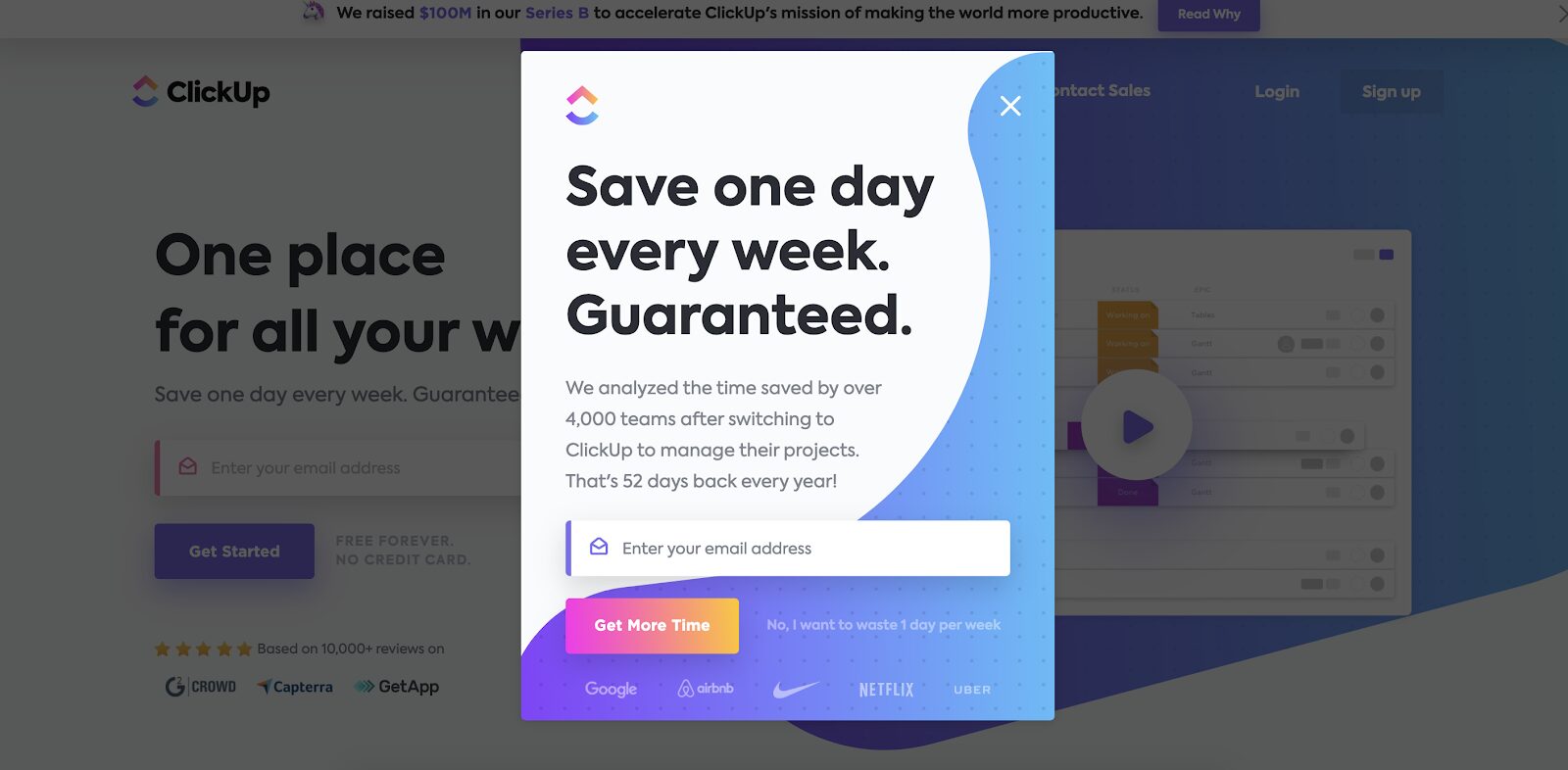
ClickUp’s B2B popup zeroes in on its core value proposition: time-saving efficiency.
By highlighting the effectiveness of their project management tool, they remind visitors of the significant benefits they stand to gain. If your product addresses a crucial pain point, this is an excellent way to emphasize it.
8. Zendesk
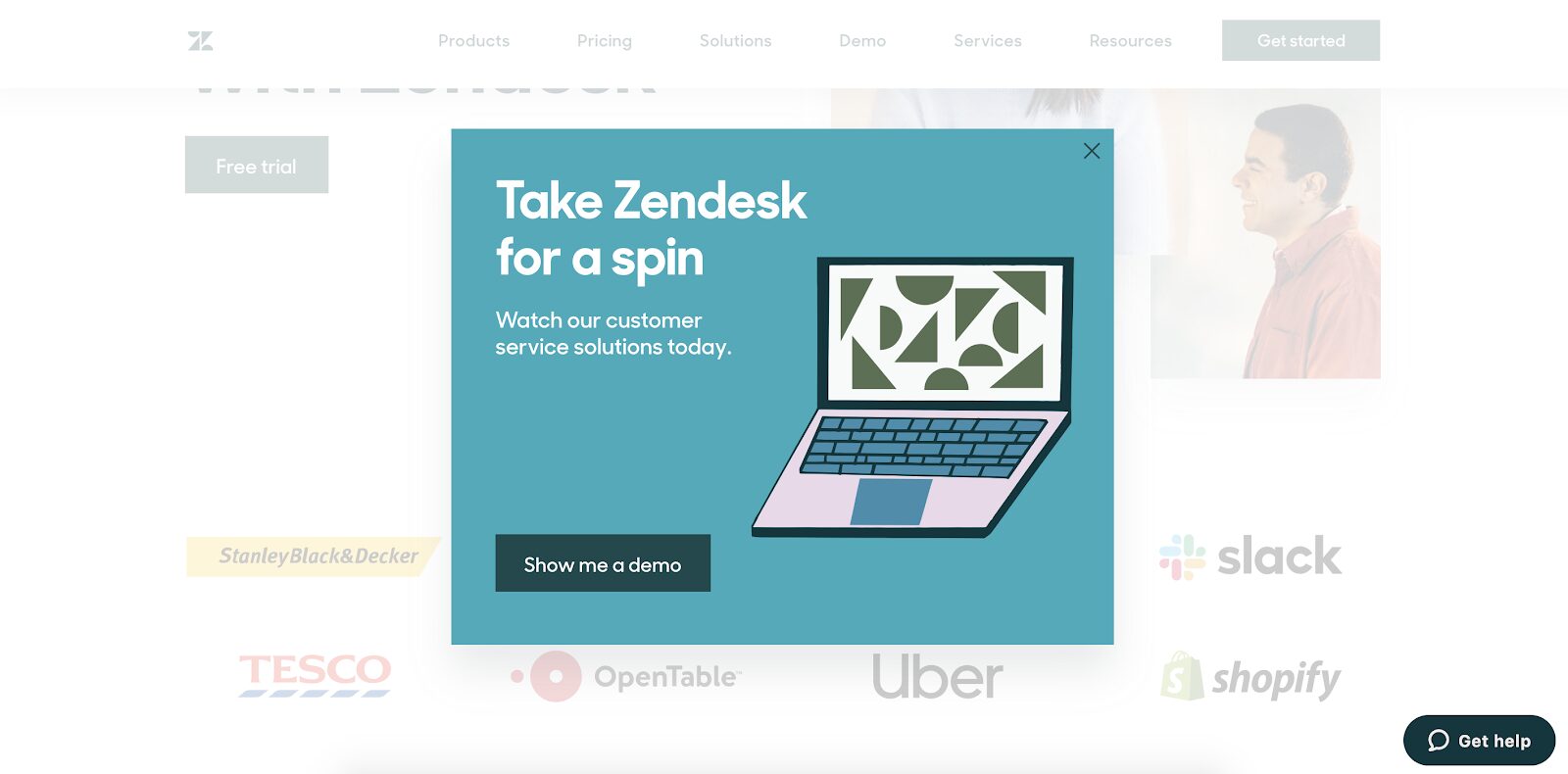
Zendesk’s popup seamlessly combines education with sales by offering a free demo. It’s a straightforward way to help visitors understand the product’s capabilities while gently guiding them toward becoming customers.
9. Twilio Segment
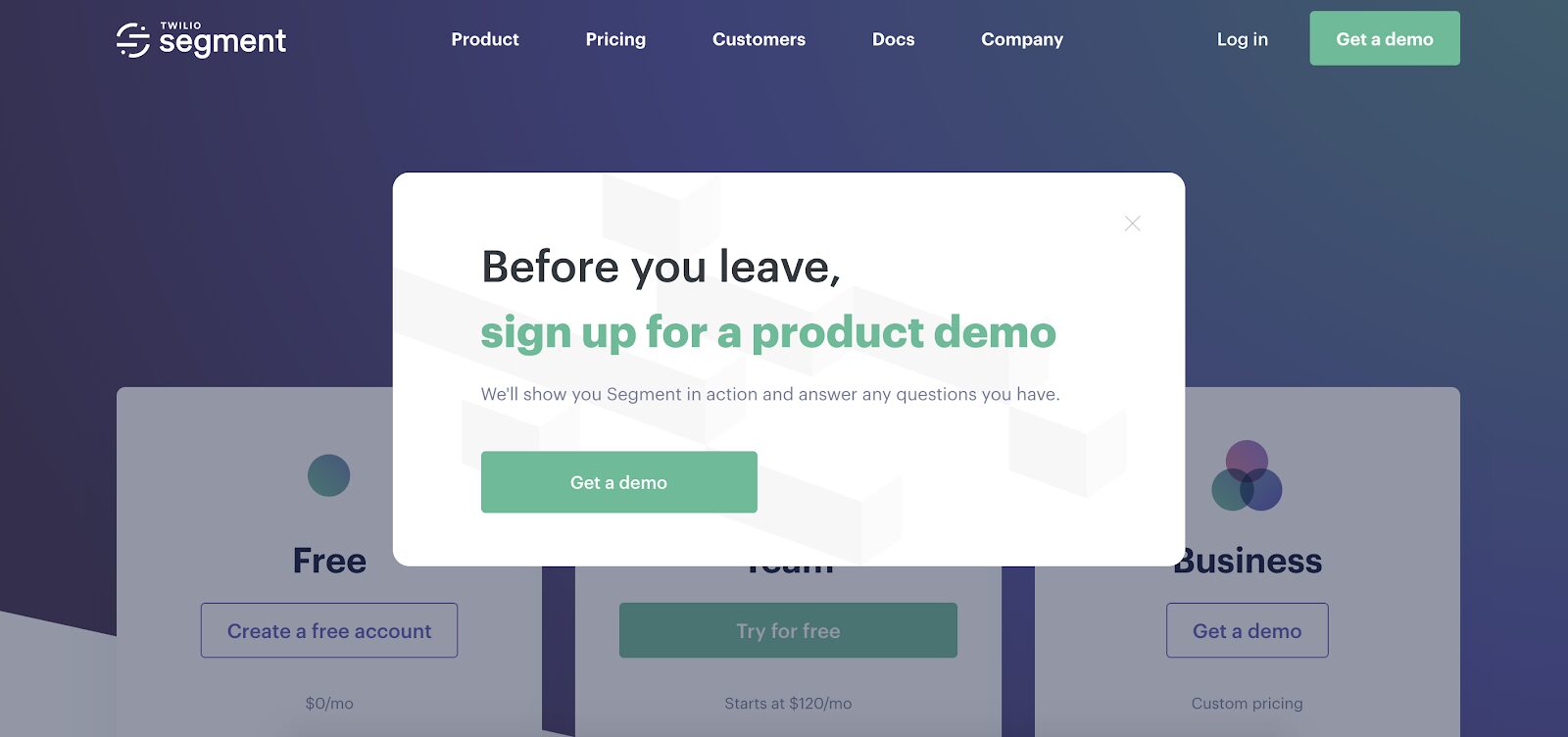
Twilio Segment’s exit-intent popup focuses on product demos.
This no-pressure approach provides potential clients with a deeper understanding of their tools while capturing valuable email addresses for lead generation.
It’s a simple yet effective way to nurture leads.
10. Userpilot
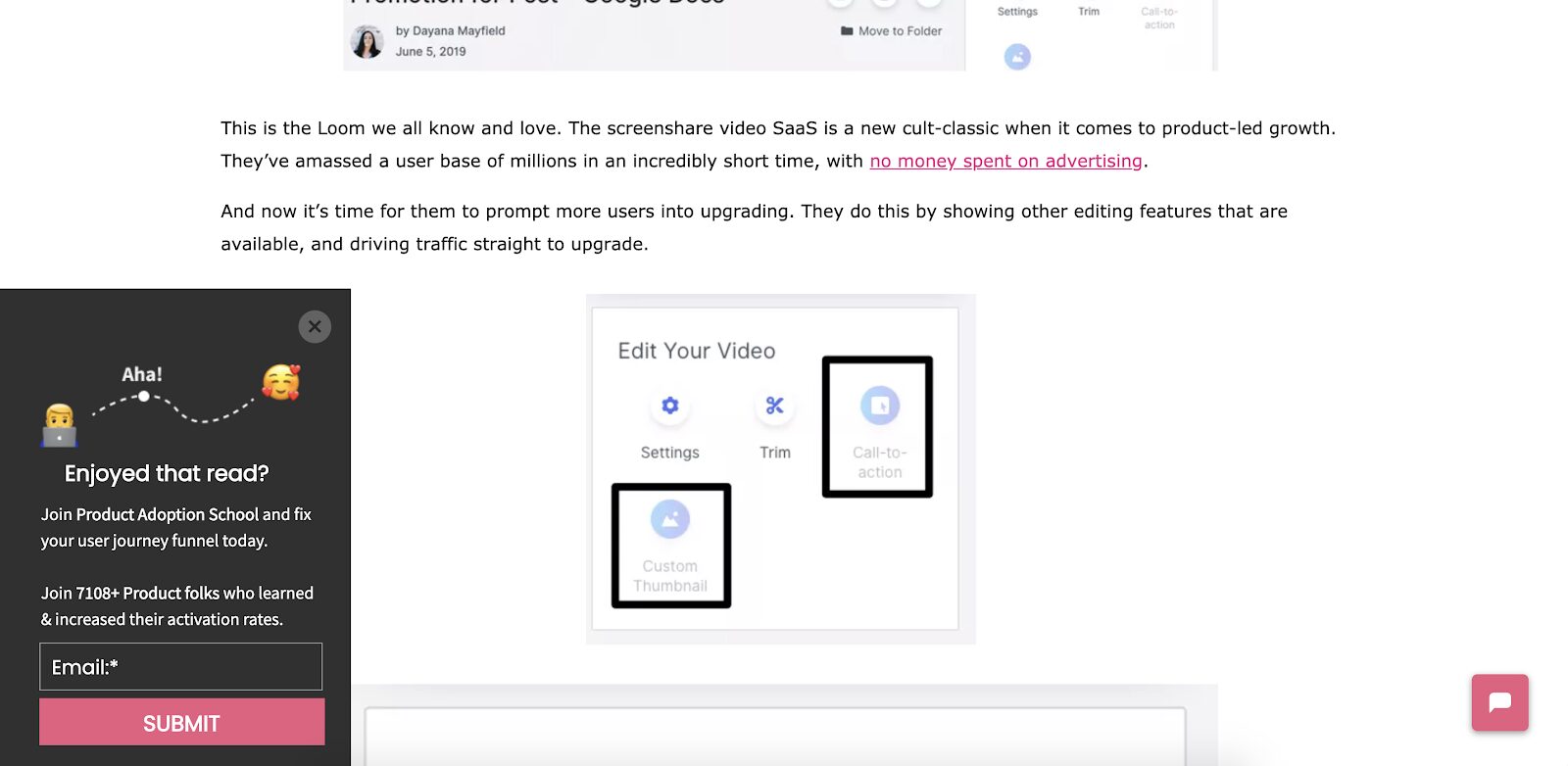
Userpilot takes a creative route with a smart sidebar popup targeting blog readers. They ask, “Enjoyed that read? Join Product Adoption School!”
By mentioning 7,000+ other participants, they use social proof to add credibility and urgency.
This strategy also helps capture organic search traffic by engaging visitors who arrive through search engines.
FAQ
What makes B2B popups different from B2C popups?
B2B popups are designed for business clients rather than individual consumers. While B2C popups often promote discounts or flash sales, a B2B popup focuses on offering value through resources like free trials, demos, case studies, whitepapers, or webinars. The tone and design are more professional, targeting decision-makers and key stakeholders.
What types of B2B popups are there?
B2B popups include lead capture popups for generating leads, exit-intent popups to retain visitors, scroll-triggered or timed popups for engagement, and slide-ins for subtle promotions.
Others, like full-screen overlays, gamified popups, multi-step forms, contextual triggers, and social proof popups, are designed to capture and convert leads strategically.
How can I ensure my B2B popups generate qualified leads?
To attract the right audience, make sure your popup:
- Offers content or resources tailored to your ideal customer’s needs.
- Uses clear, concise messaging that speaks to their pain points.
- This includes forms that collect relevant information (e.g., job title and company name).
Wrapping up
Popups aren’t just for B2C brands—they can be powerful tools for B2B marketers when done right. The examples above show that the key lies in offering genuine value, using a tone that resonates with your audience, and crafting a clear, compelling call to action.
So, whether you’re promoting a demo, free trial, or exclusive content, remember this: Your popup’s goal isn’t to annoy—it’s to help.
Done right, it can turn casual visitors into qualified leads and, ultimately, loyal clients.
Ready to get started with one of these strategies? Try these templates:
Migration has never been easier
We made switching a no-brainer with our free, white-glove onboarding service so you can get started in the blink of an eye.
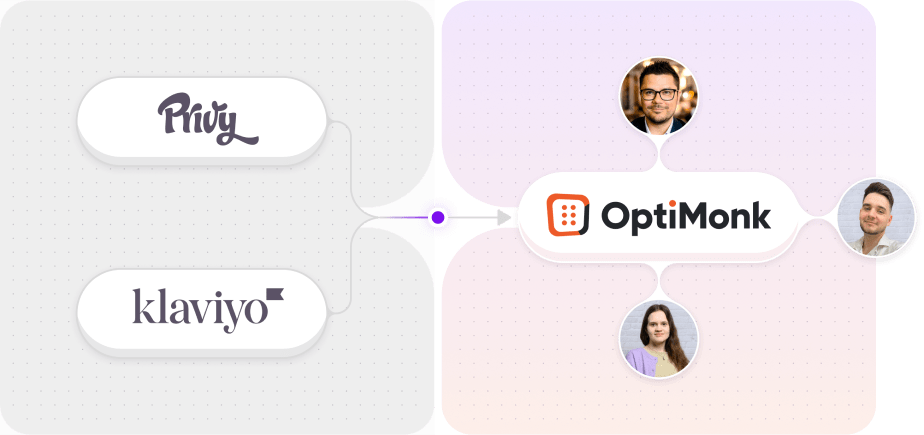
What should you do next?
Thanks for reading till the end. Here are 4 ways we can help you grow your business:
Boost conversions with proven use cases
Explore our Use Case Library, filled with actionable personalization examples and step-by-step guides to unlock your website's full potential. Check out Use Case Library
Create a free OptiMonk account
Create a free OptiMonk account and easily get started with popups and conversion rate optimization. Get OptiMonk free
Get advice from a CRO expert
Schedule a personalized discovery call with one of our experts to explore how OptiMonk can help you grow your business. Book a demo
Join our weekly newsletter
Real CRO insights & marketing tips. No fluff. Straight to your inbox. Subscribe now
Barbara Bartucz
- Posted in
- Conversion
Partner with us
- © OptiMonk. All rights reserved!
- Terms of Use
- Privacy Policy
- Cookie Policy
Product updates: January Release 2025


